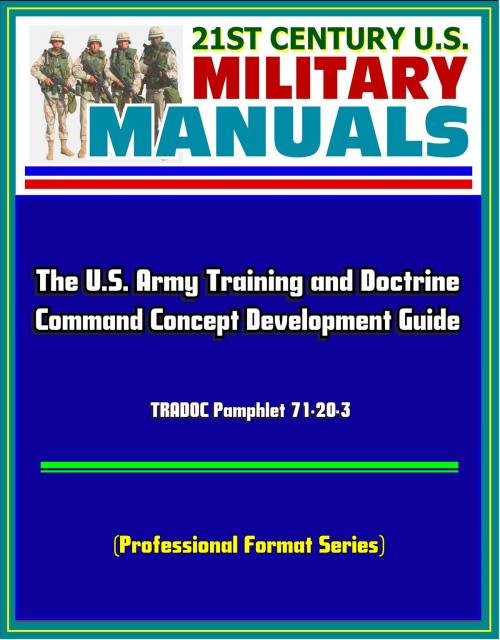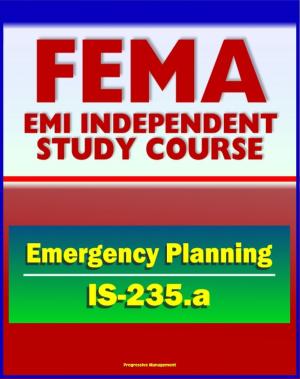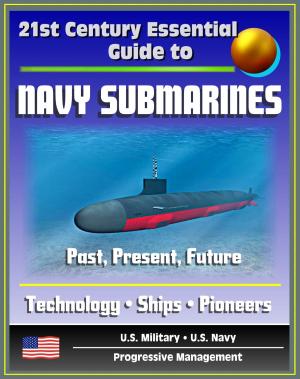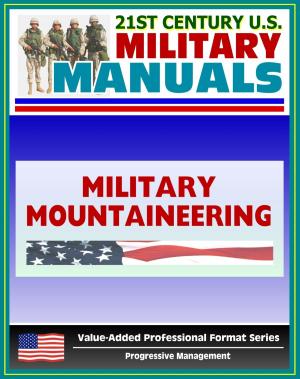21st Century U.S. Military Manuals: The U.S. Army Training and Doctrine Command Concept Development Guide - TRADOC Pamphlet 71-20-3 (Professional Format Series)
Nonfiction, History, Military, United States| Author: | Progressive Management | ISBN: | 9781301682133 |
| Publisher: | Progressive Management | Publication: | November 30, 2012 |
| Imprint: | Smashwords Edition | Language: | English |
| Author: | Progressive Management |
| ISBN: | 9781301682133 |
| Publisher: | Progressive Management |
| Publication: | November 30, 2012 |
| Imprint: | Smashwords Edition |
| Language: | English |
Professionally converted for accurate flowing-text e-book format reproduction, this publication is a new U.S. Army Training and Doctrine Command (TRADOC) guide for the development and publication of the Army Concept Framework documents.
Concepts are the foundation of the Army's implementation of the Joint Capabilities Integration and Development System (JCIDS). A concept is an idea, a thought, a general notion [inferred from specific operations or occurrences in the operational environment (OE)]. In its broadest sense a concept describes what is to be done; in its more specific sense, it can be used to describe how something is done. Concepts illustrate how future joint and Army forces may operate, describe the capabilities required to carry out the range of military operations against adversaries in the expected OE, and explain how a commander, using military art and science, might employ these capabilities to achieve desired effects and objectives. They describe a problem or series of problems to be solved, the components of the solution, and the interaction of those components in solving the problem. Concepts define how the force functions (operational concept), the timeframe and conditions in which it must operate (the OE), and what the force must be able to execute (required capabilities (RCs)) in terms of performing missions or producing the desired endstate.
Chapter 1 * Introduction * 1-1. Purpose * 1-2. References * 1-3. Explanation of abbreviations and terms * Chapter 2 * The Army Concept Framework * 2-1. Concepts and capabilities development overview * 2-2. Concepts purpose and description * 2-3. Strategic guidance * 2-4. Operational environment * 2-5. The Army Concept Framework * 2-6. Classification and distribution restriction * Chapter 3 * Developing Army Concepts * 3-1. Army concept document initiation and/or revision * 3-2. Army conceptual document approval and authentication * 3-3. Development of capstone, operating, functional, and leadership directed concepts * 3-4. Format. * 3-5. Capability statements * Chapter 4 * Staffing Procedures * 4-1. General * 4-2. Draft versions * 4-3. Action officer level review * 4-4. Colonel (0-6) level review * 4-5. General officer level review * 4-6. Comment priority designations * 4-7. Resolution of critical comments * 4-8. Concept approval * Appendix A * References * Appendix B * Guide to Formatting Army Concepts * Appendix C * Comment Resolution Matrix (CRM) * Appendix D * Sample TRADOC Form 5 for Concept Approval * Appendix E * CONOPS and White Papers
As a bonus, this reproduction includes the complete 2012 Army Leadership manual (FM 6-22), which describes the Army's view of leadership, outlines the levels of leadership (direct, organizational, and strategic), and describes the attributes and core leader competencies across all levels.
Professionally converted for accurate flowing-text e-book format reproduction, this publication is a new U.S. Army Training and Doctrine Command (TRADOC) guide for the development and publication of the Army Concept Framework documents.
Concepts are the foundation of the Army's implementation of the Joint Capabilities Integration and Development System (JCIDS). A concept is an idea, a thought, a general notion [inferred from specific operations or occurrences in the operational environment (OE)]. In its broadest sense a concept describes what is to be done; in its more specific sense, it can be used to describe how something is done. Concepts illustrate how future joint and Army forces may operate, describe the capabilities required to carry out the range of military operations against adversaries in the expected OE, and explain how a commander, using military art and science, might employ these capabilities to achieve desired effects and objectives. They describe a problem or series of problems to be solved, the components of the solution, and the interaction of those components in solving the problem. Concepts define how the force functions (operational concept), the timeframe and conditions in which it must operate (the OE), and what the force must be able to execute (required capabilities (RCs)) in terms of performing missions or producing the desired endstate.
Chapter 1 * Introduction * 1-1. Purpose * 1-2. References * 1-3. Explanation of abbreviations and terms * Chapter 2 * The Army Concept Framework * 2-1. Concepts and capabilities development overview * 2-2. Concepts purpose and description * 2-3. Strategic guidance * 2-4. Operational environment * 2-5. The Army Concept Framework * 2-6. Classification and distribution restriction * Chapter 3 * Developing Army Concepts * 3-1. Army concept document initiation and/or revision * 3-2. Army conceptual document approval and authentication * 3-3. Development of capstone, operating, functional, and leadership directed concepts * 3-4. Format. * 3-5. Capability statements * Chapter 4 * Staffing Procedures * 4-1. General * 4-2. Draft versions * 4-3. Action officer level review * 4-4. Colonel (0-6) level review * 4-5. General officer level review * 4-6. Comment priority designations * 4-7. Resolution of critical comments * 4-8. Concept approval * Appendix A * References * Appendix B * Guide to Formatting Army Concepts * Appendix C * Comment Resolution Matrix (CRM) * Appendix D * Sample TRADOC Form 5 for Concept Approval * Appendix E * CONOPS and White Papers
As a bonus, this reproduction includes the complete 2012 Army Leadership manual (FM 6-22), which describes the Army's view of leadership, outlines the levels of leadership (direct, organizational, and strategic), and describes the attributes and core leader competencies across all levels.















